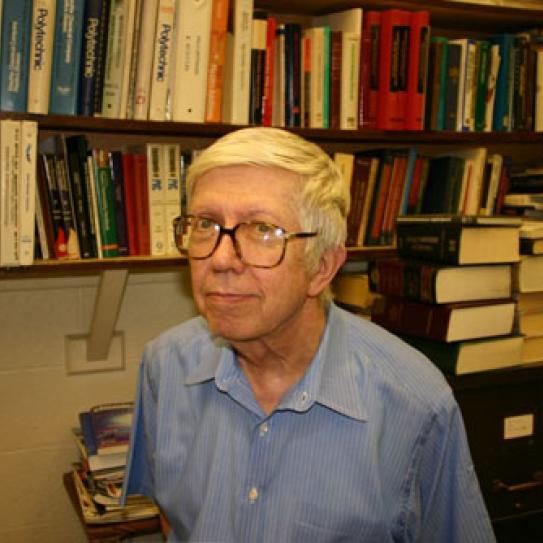
Fellowships to Honor Legacy of Polymer Research Institute Pioneers
When Dr. Edward Weil arrived at Brooklyn Poly in 1987 to begin his position as a research professor at the Polymer Research Institute (PRI), he was already known in the field for his industrial work on agricultural chemicals and flame retardant polymers. Having just retired from Stauffer Chemical Company as a senior scientist, he was casting about for a position in academic research when he called Dr. Eli Pearce, PRI’s director. Pearce invited him to come on board, launching what would become a twenty-year career that spurred many publications and even added to Weil’s more than 200 patents.
Weil hit the ground running. He began his time at the Polymer Research Institute by pitching a project to a Dutch company called DSM, which gave him funding for a post-doc. A patent and paper ensued from their research, followed by numerous contracts from big-name companies, most notably Akzo-Nobel, Eastman, 3M, Huber, U.S. Borax and BF Goodrich, as well as NASA, FAA, and Electric Power Research Institute. Over the years, the recognition of Weil’s patented and published inventions in flame retardants and other polymer-related technologies and his breadth and depth of knowledge gave him a worldwide reputation.
Equally at play was the unique environment at PRI, which encouraged faculty to pursue research partnerships with industry. “No one said what you’re doing is too applied,” said Weil, of his work with Menachem Lewin, a chemist from Hebrew University, with whom he collaborated on several industrially-sponsored projects. “We had a good balance between academic and industrial research at Poly. We often could solve real industrial problems and, often in the same projects, come up with publishable scientific results.”
That forward-looking attitude was the influence of Herman F. Mark, who founded PRI at the Polytechnic Institute of Brooklyn in 1946. Under his direction, PRI became the first facility in the U.S. dedicated to teaching all aspects of polymers, giant long-chain molecules used in plastics and other materials. Students who wanted to seriously study polymers came from many states and countries to Brooklyn Poly, to the inelegant but busy Rogers Hall on Jay Street.
During and after Professor Herman Mark’s time, more than 1,500 polymer scientists and engineers were trained at PRI, adding their scientific insights to the development of polymer technologies and scientific knowledge. One such student was Eli Pearce ‘58, who came to Brooklyn Poly in the 1950s to study with Dr. Mark and, in 1981, became PRI’s director. “Eli Pearce was a good mentor,” said Weil, “and always helpful with good advice on scientific issues.” Pearce was also an early advocate of the advancement of women and minorities in chemistry. Dr. Giuliana Tesoro, an expert in fiber and textile chemistry, and Dr. Edith Turi, a founder of thermal analysis, were among the notable women chemists at Poly at the time.
In the ensuing years, PRI remained influential, even as other universities developed polymer institutes and programs. In 2003, the American Chemical Society (ACS) designated the PRI as a National Historic Chemical Landmark, and two years later Dr. Yoshi Okamoto — who had taught at NYU’s University Heights campus before coming to Poly — ascended to the directorship.
In 2015, when Weil learned that his mentor, Eli Pearce, had died, he wished to pay tribute to him for playing such a significant part in his career. Moreover, he wanted to ensure that the legacy of the Polymer Research Institute would be preserved. Weil made a gift to the NYU Tandon School of Engineering to establish three new fellowships in the Department of Chemical and Biomolecular Engineering: the Herman Mark Fellowship, the Eli Pearce Fellowship, and the Edward Weil Fellowship. “This is a wonderful gift for three Ph.D. students to pursue research in polymer materials and science engineering,” Okamoto said of his colleague’s gift.
The days of the pioneers in polymer research such as Herman Mark may have faded, but the legacy of PRI continues in the work of NYU Tandon’s engineering faculty. The days of the pioneers in polymer research such as Herman Mark may have faded, but the legacy of PRI continues in the work of NYU Tandon's engineering faculty, especially in the area of biopolymers, polymers produced by living organisms. This research includes the biomedical applications of sugar polymers (Mary Cowman), the therapeutic uses of engineered proteins (Jin Montclare, Jin Ryoun Kim), and biopolymer sensing and diagnostics (Rastislav Levicky, Stephen Arnold).
”The Polymer Research Institute had excellent reputation in its day. Its long tradition and memory should be preserved,” said Weil. Thanks to his visionary gift, that is sure to happen.
Education
University of Pennsylvania 1950
Bachelor of Science, Chemistry
Pace University
Master of Business Administration, Management
University of Illinois 1953
Doctor of Philosophy, Organic (Polymer) Chemistry
Experience
Hooker Chemical Co.
Research chemist
Invented and developed numerous agricultural chemicals, polymer additives, and manufacturing processes. Over 100 issued patents, several commercialized products and processes. Mostly halogen, sulfur, phosphorus chemistry.
Stauffer Chemical Co. Research Center
Senior Scientist
Invented and developed many flame retardants for textiles, polymers and foams. Also agricultural chemicals, plasticizers and other polymer additives. Over 100 US patents. Publications. Won IR-100 Award for textile flame retardant finish. Research planning, new project initiation, scientific liaison. Phosphorus, sulfur, halogen chemistry here also.
Polytechnic Institute of New York University
Research Professor
Since 1987, obtaining, planning and administering post-doctoral research at Polytechnic University, sponsored by industry, trade organizations and government, mostly in the area of flame retardants, phosphorus technology, and corrosion inhibition. Publications and patents have come from this work, and some of my products are in the commercial development stage in the US, Europe and the Far East.

